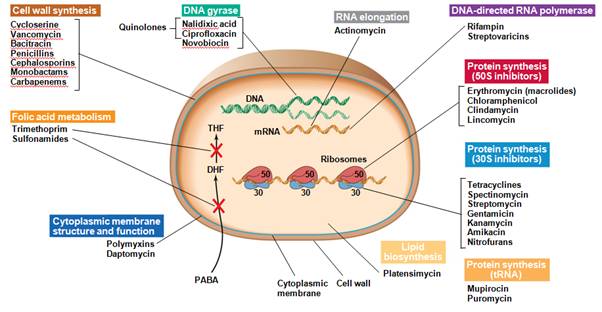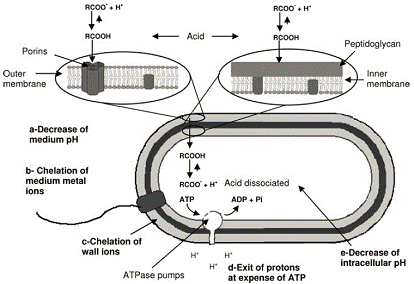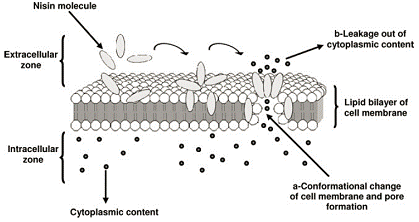

Mechanism of antimicrobials
1. Mechanism of antimicrobials
1) Acting on cell wall and cell membrane system.
2) Acting on genetic material and genetic particle structure.
3) Acting on enzymes or functional proteins.
2. Pharmaceutical antimicrobials
1) Action of some major pharmaceutical antimicrobial agents.

2) Spectrum of activity of pharmaceutical antimicrobials

3. Food antimicrobials
1) Action of phenolic compounds
An antimicrobial action of phenolic compounds was related to inactivation of cellular enzymes, which depended on the rate of penetration of the substance into the cell or caused by membrane permeability changes. Increased membrane permeability is a major factor in the mechanism of antimicrobial action, where compounds may disrupt membranes and cause a loss of cellular integrity and eventual cell death. Also, the number and position of substitutions in the benzene ring of the phenolic acids and the saturated side-chain length influenced the antimicrobial potential of the phenolic acids against the different microorganisms.
Active compounds such as thymol, eugenol, and carvacrol have been shown to cause disruption of the cellular membrane, inhibition of ATPase activity, and release of intracellular ATP and other constituents of several microorganisms such as E. coli, L. monocytogenes, Lactobacillus sakei, Pseudomonas aeruginosa, Salmonella enteritidis, and S. aureus. However, it is also indicated that cinnamon oil and cinnamaldehyde produced a decrease in the intracellular ATP by ATPase activity without apparent changes on the cell membrane of E. coli, and L. monocytogenes.
2) Action of organic acids
The key basic principle on the mode of action of organic acids on bacteria is that non-dissociated (non-ionized) organic acids can penetrate the bacteria cell wall and disrupt the normal physiology of certain types of bacteria that we call pH-sensitive, meaning that they cannot tolerate a wide internal and external pH gradient. Among those bacteria are Escherichia coli, Salmonella spp., Clostridium perfringens, Listeria monocytogenes, and Campylobacter species.

Mechanisms of action of organic acids in a bacterial cell
The left figure illustrates how the organic acids can pass through the outer membrane in Gram-negative bacteria, whereas the right figure shows how they can pass through the inner membrane in Gram-positive bacteria.
3) Action of essential oils
It is most likely that the antibacterial activity of the essential oils is not attributable to one specific mechanism but to action over several specific targets in the cell Iike degradation of the cell wall, damage to cytoplasmic membrane and membrane proteins, leakage contents out of the cell, coagulation of cytoplasm, and depletion of the proton motive force. It is indicated that the mode of action of essential oils is concentration dependent, indicating that low concentrations inhibit enzymes associated with energy production, while higher amounts may precipitate proteins.

Mechanisms of action of essential oils and their components in a bacterial cell
4) Action of nisin
Nisin, a small, heat-stable antimicrobial peptide of 34 amino acids produced by Lactococcus lactis subsp. Lactis.
It has shown a narrow antimicrobial spectrum, inhibiting only Gram-positive bacteria, including Alicyclobacillus, Bacillus cereus, Brochothrix thermosphacta, Clostridium botulinum,Clostridium sporogenes, Desulfotomaculum, Enterococcus, Lactobacillus, Leuconostoc, L. monocytogenes, Micrococcus, Pediococcus, Sporolactobacillus, and Staphylococcus. On the other hand, nisin does not generally inhibit Gram-negative bacteria, yeasts, or molds. In vegetative cells the primary site of action for nisin is the cytoplasmic membrane where it forms pores, thus destroying membrane integrity, and acts as a voltagedependent polarizer. Pore formation results in depletion of proton motive force and loss of cellular ions, amino acids, and ATP.

Mechanism of action of nisin in a bacterial cell
Reference:
1. Hayriye Cetin-Karaca ,Evaluation of natural antimicrobial phenolic compounds against foodborne pathogens, 2011